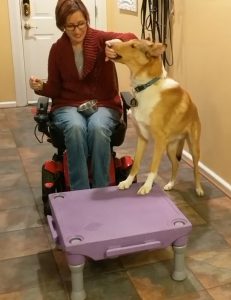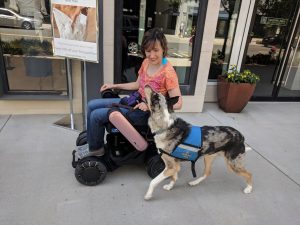By Veronica Sanchez

Working with clients who have physical limitations and their dogs sometimes requires some creative troubleshooting but is extremely rewarding © Veronica Sanchez
A large and rambunctious dog can pull an owner off their feet, even if they do not have any physical limitations. However, people who have mobility impairments are at a higher risk. Additionally, the consequences of an injury may be more serious. Fortunately, there are a variety of strategies that can help clients with mobility limitations be successful in training their dogs to walk on a loose leash.
Many people may experience a mobility limitation, including people with disabilities, people with temporary health injuries as well as seniors. Some individuals may need adaptive equipment like crutches, canes, casts or wheelchairs, while other people with mobility impairments may use strategies like walking slowly and taking frequent breaks.
Clearly, mobility impairments do not affect everyone the same way. This applies even if people use the same type of adaptive equipment. For instance, one individual using a wheelchair may have full use of their arms and hands, while another may not. People with the same diagnosis can have different limitations. Many conditions, like cerebral palsy, for example, can have a range of ways they affect individuals. Because of this, it is important not to make assumptions. Training strategies and accommodations need to be matched to the unique needs of the client.

Mobility impairments do not affect everyone the same way so it is important not to make assumptions: training strategies and accommodations need to be matched to the unique needs of the client. © Veronica Sanchez
Here are five tips when working with clients with mobility impairments:
- Scan the training space for trip hazards, uneven surfaces and curbs to make sure it is safe for your client.
- Begin training by working off leash in an enclosed area.
- Leashes can get entangled in wheelchairs and walkers. Be ready to experiment to find a leash that is an appropriate length.
- Take the time to train the dog to walk up and down stairs and curbs in a calm, controlled way.
- Extra help may be needed. A friend can hold a second leash, so the owner can drop the leash if needed. Or you can work with the dog in day training or board and train at first.
Working with clients who have physical limitations and their dogs sometimes requires a bit of creative troubleshooting but is extremely rewarding. By learning how to accommodate clients with mobility limitations in training, force-free trainers can improve the lives of both owners and their dogs.
Read more on this topic in Helping Owners, Helping Dogs, BARKS from the Guild, March 2019, pp. 28-30.
About the Author
Veronica Sanchez M.Ed, CABC, CPDT-KA is the founder of Cooperative Paws Service Dog Coach™, an educational certification program for professional trainers in service dog training and a Pet Professional Guild corporate partner. She is also the author of the book, Service Dog Coaching: A Guide for Pet Dog Trainers, to be published this year. As a dog trainer with a disability, her passion for service dogs is personal as well as professional. You can learn more about Veronica and her educational programs online at www.cooperativepaws.com.
